Table of Contents
Embark on an empowering journey to sculpt an impressive upper body with calisthenics, the highly effective and convenient form of bodyweight training. By leveraging this beginner-friendly guide, you'll uncover the fundamental exercises, grasp their benefits, and embark on a tailored workout plan meticulously designed for upper body calisthenics beginners on Kizworld.com.
Upper Body Calisthenics for Beginners: A Comprehensive Guide to Building Strength and Muscle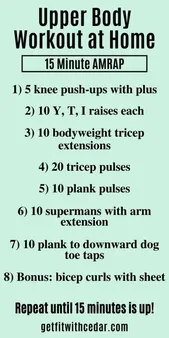
I. Progression Table
Exercise | Beginner | Intermediate | Advanced |
|---|---|---|---|
Wall Push-Ups | 4-6 sets of 12-15 reps | 4-6 sets of 15-20 reps | 4-6 sets of 20-25 reps |
Incline Push-Ups | 4-6 sets of 10-12 reps | 4-6 sets of 12-15 reps | 4-6 sets of 15-20 reps |
Regular Push-Ups | 4-6 sets of 8-10 reps | 4-6 sets of 10-15 reps | 4-6 sets of 15-20 reps |
Tricep Dips | 4-6 sets of 10-12 reps | 4-6 sets of 12-15 reps | 4-6 sets of 15-20 reps |
Pike Push-Ups | 4-6 sets of 6-8 reps | 4-6 sets of 8-10 reps | 4-6 sets of 10-12 reps |
Banded Archers | 4-6 sets of 10-12 reps | 4-6 sets of 12-15 reps | 4-6 sets of 15-20 reps |
Wide-Stance Push-Ups | 4-6 sets of 8-10 reps | 4-6 sets of 10-15 reps | 4-6 sets of 15-20 reps |
Diamond Push-Ups | 4-6 sets of 6-8 reps | 4-6 sets of 8-10 reps | 4-6 sets of 10-12 reps |
Muscle-Ups | 4-6 sets of 3-5 reps | 4-6 sets of 5-8 reps | 4-6 sets of 8-10 reps |
Handstand Push-Ups | 4-6 sets of 2-3 reps | 4-6 sets of 3-5 reps | 4-6 sets of 5-8 reps |
II. Starting out with upper body calisthenics for beginners
Getting started with bodyweight training
Calisthenics is a great way to get in shape and build strength without using any weights. It's a versatile form of exercise that can be done anywhere, and it's suitable for people of all ages and fitness levels.If you're new to calisthenics, there are a few things you should keep in mind. First, start slowly and gradually increase the difficulty of your workouts over time. Second, focus on proper form to avoid injury. Third, be patient and consistent with your training. With time and effort, you'll be able to achieve your fitness goals. Read more about the basics of calisthenics
Beginner-friendly calisthenics exercises
There are many different calisthenics exercises that you can do, but some of the most beginner-friendly exercises include:
- Push-ups
- Squats
- Lunges
- Planks
- Bodyweight rows
These exercises can be modified to make them easier or more difficult, depending on your fitness level. Discover the benefits of calisthenics
Exercise | Beginner | Intermediate | Advanced |
|---|---|---|---|
Push-Ups | On knees | Regular | Decline |
Squats | Bodyweight | Weighted | Pistol |
Lunges | Forward | Reverse | Jumping |
Planks | 30 seconds | 60 seconds | 90 seconds |
Bodyweight Rows | Assisted | Regular | Weighted |
Learn more about calisthenics exercises
Starting out with upper body calisthenics for beginners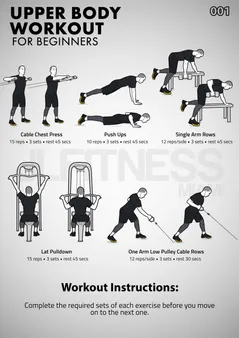
III. Progression to advance the upper calisthenics skill
Master the basics
Before you can progress to more advanced upper body calisthenics exercises, it's important to master the basics. This means being able to perform the following exercises with good form:
- Push-ups
- Pull-ups
- Dips
- Rows
- Planks
Once you can perform these exercises with good form, you can start to progress to more advanced variations.
Increase the difficulty
One way to progress in upper body calisthenics is to increase the difficulty of the exercises you're doing. This can be done by:
- Increasing the number of repetitions
- Increasing the number of sets
- Increasing the weight you're using
- Decreasing the rest time between sets
As you get stronger, you'll be able to increase the difficulty of your workouts and continue to progress.
Try new exercises
Another way to progress in upper body calisthenics is to try new exercises. There are many different upper body calisthenics exercises that you can do, so there's always something new to learn. Trying new exercises will help you to develop new skills and challenge your body in new ways.
Here are a few examples of advanced upper body calisthenics exercises:
- Muscle-ups
- Handstand push-ups
- Planche push-ups
- Front lever
- Back lever
These exercises are challenging, but they're also very rewarding. If you're looking to take your upper body calisthenics skills to the next level, give these exercises a try.
Be patient and consistent
Progressing in upper body calisthenics takes time and consistency. Don't get discouraged if you don't see results immediately. Just keep at it and you will eventually reach your goals.
Here are a few tips to help you stay motivated:
- Set realistic goals
- Find a workout buddy
- Track your progress
- Reward yourself for your accomplishments
With patience and consistency, you can achieve anything you set your mind to. So don't give up on your upper body calisthenics goals. Keep working hard and you will eventually reach them.
Exercise | Beginner | Intermediate | Advanced |
|---|---|---|---|
Push-ups | 4-6 sets of 12-15 reps | 4-6 sets of 15-20 reps | 4-6 sets of 20-25 reps |
Pull-ups | 4-6 sets of 8-10 reps | 4-6 sets of 10-15 reps | 4-6 sets of 15-20 reps |
Dips | 4-6 sets of 10-12 reps | 4-6 sets of 12-15 reps | 4-6 sets of 15-20 reps |
Rows | 4-6 sets of 10-12 reps | 4-6 sets of 12-15 reps | 4-6 sets of 15-20 reps |
Planks | 4-6 sets of 30-60 seconds | 4-6 sets of 60-90 seconds | 4-6 sets of 90-120 seconds |
Here are some related posts that you may find helpful:
- How to do a muscle-up
- The best calisthenics gifts and accessories
- The best calisthenics quotes and motivation
Progression to advance the upper calisthenics skill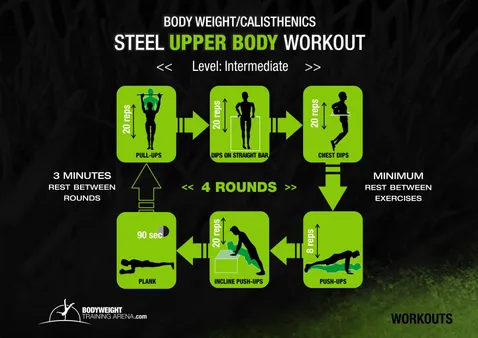
IV. Common mistake and how to address it at the early stage
Mistake 1: Not warming up properly
Warming up is essential for any workout, but it's especially important for upper body calisthenics. When you don't warm up, you're more likely to injure yourself. To warm up properly, start with some light cardio, such as jumping jacks or running in place. Then, do some dynamic stretches, such as arm circles and leg swings. Finally, do some light calisthenics exercises, such as push-ups and pull-ups.
Mistake 2: Trying to do too much too soon
When you're first starting out with upper body calisthenics, it's important to start slowly and gradually increase the difficulty of your workouts. If you try to do too much too soon, you're more likely to get injured or discouraged. Start with a few basic exercises and focus on building a solid foundation. Once you've mastered the basics, you can start adding more challenging exercises to your routine.
Mistake 3: Not using proper form
Proper form is essential for any exercise, but it's especially important for upper body calisthenics. When you don't use proper form, you're more likely to injure yourself. Make sure to learn the proper form for each exercise before you start doing it. You can find videos and tutorials online, or you can ask a personal trainer for help.
Mistake 4: Not resting enough
Rest is just as important as exercise. When you don't rest enough, your muscles don't have time to recover. This can lead to injuries and decreased performance. Make sure to get plenty of rest between sets and workouts. You should also take a day off from exercise each week to give your body time to recover.
Mistake 5: Not eating a healthy diet
Eating a healthy diet is essential for any fitness routine. When you don't eat a healthy diet, your body doesn't have the nutrients it needs to recover from workouts and build muscle. Make sure to eat plenty of fruits, vegetables, and whole grains. You should also limit your intake of processed foods, sugary drinks, and unhealthy fats.
Exercise | Beginner | Intermediate | Advanced |
|---|---|---|---|
Wall Push-Ups | 4-6 sets of 12-15 reps | 4-6 sets of 15-20 reps | 4-6 sets of 20-25 reps |
Incline Push-Ups | 4-6 sets of 10-12 reps | 4-6 sets of 12-15 reps | 4-6 sets of 15-20 reps |
Regular Push-Ups | 4-6 sets of 8-10 reps | 4-6 sets of 10-15 reps | 4-6 sets of 15-20 reps |
Tricep Dips | 4-6 sets of 10-12 reps | 4-6 sets of 12-15 reps | 4-6 sets of 15-20 reps |
Pike Push-Ups | 4-6 sets of 6-8 reps | 4-6 sets of 8-10 reps | 4-6 sets of 10-12 reps |
Banded Archers | 4-6 sets of 10-12 reps | 4-6 sets of 12-15 reps | 4-6 sets of 15-20 reps |
Wide-Stance Push-Ups | 4-6 sets of 8-10 reps | 4-6 sets of 10-15 reps | 4-6 sets of 15-20 reps |
Diamond Push-Ups | 4-6 sets of 6-8 reps | 4-6 sets of 8-10 reps | 4-6 sets of 10-12 reps |
Muscle-Ups | 4-6 sets of 3-5 reps | 4-6 sets of 5-8 reps | 4-6 sets of 8-10 reps |
Handstand Push-Ups | 4-6 sets of 2-3 reps | 4-6 sets of 3-5 reps | 4-6 sets of 5-8 reps |
Related post: How to do a muscle up
Common mistake and how to address it at the early stage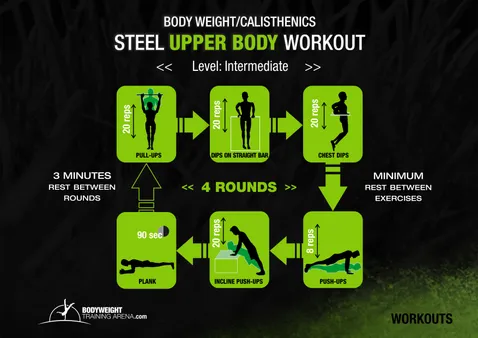
V. Tips on optimizing upper body calisthenics training
Progressive Overload
To continuously challenge your muscles and promote growth, gradually increase the difficulty of your workouts. This can be achieved by adding more repetitions, sets, or weight to your exercises over time. For example, if you can currently perform 10 push-ups, aim to increase this to 12-15 push-ups in your next workout. By consistently pushing your limits, you will stimulate muscle growth and strength gains.
Proper Form and Technique
Maintaining proper form is crucial for maximizing the effectiveness of your calisthenics training and preventing injuries. Focus on engaging the correct muscle groups and executing exercises with precision. Avoid swinging or using momentum to complete repetitions, as this can compromise your form and limit progress. If you are unsure about the proper technique for an exercise, consult a qualified trainer or refer to online resources for guidance.
Exercise | Beginner | Intermediate | Advanced |
|---|---|---|---|
Wall Push-Ups | 4-6 sets of 12-15 reps | 4-6 sets of 15-20 reps | 4-6 sets of 20-25 reps |
Incline Push-Ups | 4-6 sets of 10-12 reps | 4-6 sets of 12-15 reps | 4-6 sets of 15-20 reps |
Regular Push-Ups | 4-6 sets of 8-10 reps | 4-6 sets of 10-15 reps | 4-6 sets of 15-20 reps |
Adequate Rest and Recovery
Rest and recovery are essential components of any fitness program, and calisthenics is no exception. Allow your muscles sufficient time to repair and rebuild after each workout. Aim for 24-48 hours of rest between training sessions for the same muscle group. During this time, engage in light activities or complete rest to promote muscle recovery and prevent overtraining.
Nutrition and Hydration
Fuel your body with a balanced diet that supports your training goals. Consume adequate protein to support muscle growth and repair, and ensure you are consuming enough calories to meet your energy demands. Stay hydrated by drinking plenty of water throughout the day, especially before, during, and after your workouts.
- How to Do a Muscle-Up
- The Best Calisthenics Gifts and Accessories
- The Best Calisthenics Quotes and Motivation
Tips on optimizing upper body calisthenics training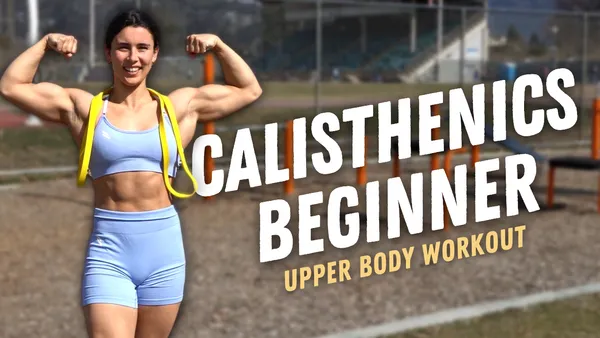
VI. Conclusion
Congratulations on taking the first step towards improving your upper body strength and fitness with calisthenics! Remember to start slowly and gradually increase the difficulty of your workouts as you get stronger. Listen to your body and rest when you need to. With consistency and dedication, you will be amazed at how much progress you can make. If you have any questions or need further guidance, don't hesitate to reach out to a qualified fitness professional or visit our website at kizworld.com for more information and resources.